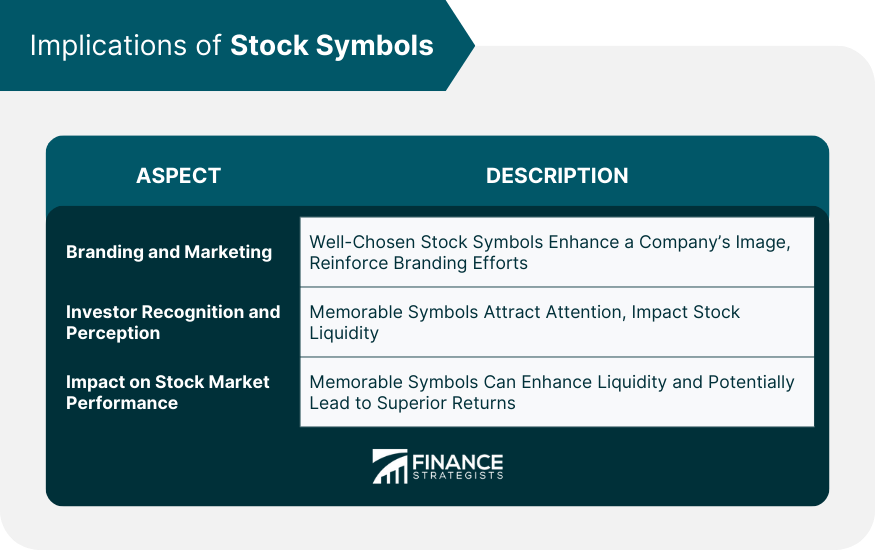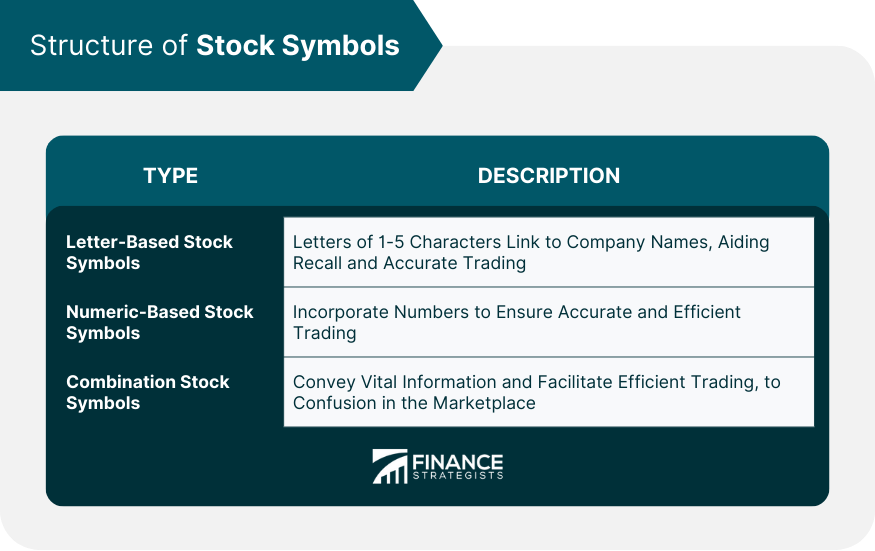A stock symbol, also known as a ticker symbol, is a unique series of characters assigned to a security for trading purposes. It's a type of shorthand or code that traders and investors use to identify publicly traded shares of a particular stock on a specific stock exchange. For example, the stock symbol for Microsoft is MSFT, and that for Apple Inc. is AAPL. Fundamentally, the stock symbol is a digital passport that confirms a company's identity in the financial market. Its use streamlines and simplifies transactions, making the stock market more efficient and accessible. Stock symbols provide a common language through which global financial market participants can communicate, fostering seamless cross-border transactions. They're an indispensable component of financial news and reports, serving as a cornerstone for financial data tracking, analysis, and forecasting. A cleverly chosen symbol can enhance a company's image and increase its memorability among investors. As such, it becomes a part of a company's identity, just as its logo or name does. Some companies opt for symbols that directly reflect their brand. For instance, the Ford Motor Company uses 'F' as its stock symbol, which immediately links the symbol to the company's name. In this way, a well-selected stock symbol can contribute to a company's branding efforts, reinforcing its presence in the investor's mind. The power of a stock symbol stretches to shaping investor recognition and perception. A symbol that is easy to remember and recognize can garner more attention from investors, potentially affecting a company's stock liquidity. Furthermore, a symbol that resonates with a company's industry or business might influence investor perception. For example, a biotech company using 'BIO' as part of its stock symbol could create a stronger association with its sector, enhancing its identity among investors. The influence of a stock symbol may even extend to a company's stock market performance. Although a company's financial health and market conditions primarily drive this, some research suggests that stocks with memorable and likable symbols may experience enhanced liquidity and possibly even superior returns. Letter-based stock symbols are the most common and familiar to many. They consist solely of letters from the alphabet and range from one to five characters in length. For example, 'T' is the stock symbol for AT&T, while 'GOOGL' represents Alphabet Inc., the parent company of Google. These symbols often link to the company's name or brand, providing a mnemonic device for investors. They facilitate efficient and accurate trading, serving as a unique identifier in the complex world of stock markets. This type of stock symbol is less common and typically found on the Asian markets, such as the Hong Kong Stock Exchange or the Shanghai Stock Exchange. For instance, the Bank of China trades under the numeric stock symbol '3988' on the Hong Kong Stock Exchange. A numeric-based stock symbol may seem unusual to some investors, but it plays the same critical role as its alphabetical counterpart, ensuring accurate and efficient trading operations. Combination stock symbols, as the name suggests, combine both letters and numbers. This format is often seen in the case of mutual funds and warrants, where the additional numbers provide extra information about the type of security. While these symbols might appear more complex, they serve to impart crucial details swiftly and accurately. Just as with other formats, the ultimate goal is to ensure efficient trading and avoid confusion in the financial marketplace. When choosing a stock symbol, companies often prioritize memorability and recognizability. A symbol that's easily recalled or recognized can help the company stand out in a crowded market and can potentially attract more investors. To increase memorability, companies often select symbols that resonate with their brand or company name. For instance, Starbucks Corporation uses the stock symbol 'SBUX,' making it easily identifiable for anyone familiar with the Starbucks brand. Relevance to the company's name or business is another significant consideration when selecting a stock symbol. Companies tend to choose symbols that reflect their brand, industry, or line of business, thereby creating a stronger connection with investors. A company like Southwest Airlines, for instance, uses 'LUV,' highlighting its commitment to customer service and also harking back to its origins at Dallas Love Field airport. Preventing confusion with existing stock symbols is another critical factor during the selection process. As stock symbols uniquely identify each publicly traded company, it's vital to avoid duplications or similarities that might cause investor confusion or trading errors. The selection process, therefore, involves thorough checks to ensure the proposed symbol doesn't closely resemble any existing symbols and isn't likely to be misinterpreted. Single-letter stock symbols are considered prestigious in the financial world. They're typically reserved for major corporations on large stock exchanges. For example, 'F' stands for Ford Motor Company, and 'V' represents Visa Inc. These symbols, despite their simplicity, carry considerable weight and recognizability. They serve as prime examples of the influence and significance that a well-chosen stock symbol can hold. Acronym-based stock symbols are common among companies with longer names or those wanting to encapsulate their brand in a memorable way. For example, Microsoft Corporation uses the symbol 'MSFT,' while the Bank of America Corporation trades under 'BAC.' Such symbols make it easier for investors to remember and identify the companies they're investing in, playing a vital role in enhancing brand recognition. Numeric stock symbols, although less common in Western markets, are quite typical in Asian stock exchanges. The Bank of China's '3988' and PetroChina's '0857' are prime examples of this type. While the usage of numeric symbols might be culturally specific, their function remains the same – to serve as unique identifiers that facilitate efficient trading operations. The stock symbol, a shorthand code that represents a publicly traded company, plays a critical role in financial markets. It serves not just as an identifier, but as a vital tool for trading operations, investor recognition, and even branding. The format of stock symbols varies, with some comprised of letters, others of numbers, and some a combination of both. Regardless of their structure, the ultimate purpose of these symbols is to ensure efficient and clear trading. When choosing a symbol, companies consider several factors such as memorability, relevance to their business, and avoidance of confusion with existing symbols. The end goal is to enhance the company's visibility and recognition in the market.What Is a Stock Symbol (Ticker)?
Implications and Significance of Stock Symbols
Branding and Marketing
Investor Recognition and Perception
Impact on Stock Market Performance

Structure and Format of Stock Symbols
Letter-Based Stock Symbols
Numeric-Based Stock Symbols
Combination Stock Symbols

Criteria for Stock Symbol Selection
Memorability and Recognizability
Relevance to the Company's Name or Business
Avoidance of Confusion With Existing Symbols
Stock Symbol Examples
Single-Letter Stock Symbols
Acronym-Based Stock Symbols
Numeric Stock Symbols
Conclusion
Stock Symbol FAQs
A stock symbol, also known as a ticker symbol, is a unique series of letters, numbers, or a combination of both, used to identify a publicly traded company's stock.
Stock symbols are vital for swift and accurate trading operations. They provide a unique identifier for each company, preventing confusion and errors in the trading process. They also aid in tracking financial data and trends.
Companies consider several factors when selecting a stock symbol. These include memorability, recognizability, relevance to the company's name or business, and avoidance of confusion with existing symbols.
Stock symbols can be letter-based, numeric-based, or a combination of both. The format depends on the specific stock exchange's rules and the company's preference.
While a company's financial health and market conditions primarily determine its stock performance, some research suggests that memorable and likable stock symbols may enhance stock liquidity and possibly even result in superior returns.
True Tamplin is a published author, public speaker, CEO of UpDigital, and founder of Finance Strategists.
True is a Certified Educator in Personal Finance (CEPF®), author of The Handy Financial Ratios Guide, a member of the Society for Advancing Business Editing and Writing, contributes to his financial education site, Finance Strategists, and has spoken to various financial communities such as the CFA Institute, as well as university students like his Alma mater, Biola University, where he received a bachelor of science in business and data analytics.
To learn more about True, visit his personal website or view his author profiles on Amazon, Nasdaq and Forbes.















